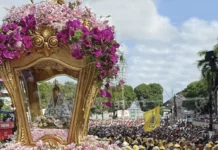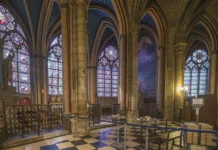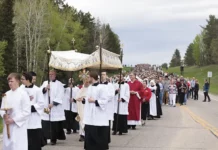Statue of Our Lady unscathed after hurricane
The inhabitants of the Archipelago of San Andrés, Providencia and Santa Catalina, situated in the Caribbean but belonging to Colombia, were amazed that a monumental statue of the Virgin Mary erected there remained unscathed amidst the destruction caused by Hurricane Iota.
The occurrence was so remarkable that even the Colombian president, Iván Duque, reported the incident during his television program Prevención y Acción: “It is really striking to see that, after a category five storm hit the island of Providencia, the statue of Our Lady remained standing. And many people today told me that she is miraculous, for she has prevented many deaths on our island.”

Chile: Original Crown Restored to Statue of Immaculate Conception
On December 8, the scaffolding that for almost a month had covered the statue of the Immaculate Conception located atop Mount San Cristobal in Santiago de Chile was removed. In a ceremony limited to 200 attendees, the Apostolic Nuncio, Archbishop Alberto Ortega Martín blessed the statue.
Erected in 1908 and located at the highest point of the city, the statue, over twenty-two metres high, marks the panorama of the Chilean capital. The refurbishment work involved fixing cracks, cleaning and painting the surface. It also provided the opportunity to restore the twelve-star crown that originally adorned the head of Our Lady.
Protests in France against Mass suspension
In the first half of November, hundreds of Catholics took part in marches, protests, prayers and hymns in front of churches in Versailles, Nantes and other cities, in defence of their right to religious worship. They were responding to draconian restrictions imposed by the French government on account of the pandemic.
Their efforts were supported by some prelates, including Bishop Dominique Marie Jean Rey of Fréjus-Toulon diocese, who recalled: “More than ever, our society needs God to face the fears and uncertainties that weigh upon the present times.”
As a result of the protests, the French government authorized Eucharistic celebrations in churches at the end of November, albeit with restricted attendance, distancing and other significant measures in place.
Studies document increase in religious persecution
According to a report released in mid-November by the Organization for Security and Co-operation in Europe (OSCE), 595 hate crimes against Christian targets were recorded during the year 2019. The countries most severely affected were France, Germany, Spain, Italy and Poland. In addition to the sacrileges committed against the Blessed Sacrament, there were attacks on churches, which were burned, damaged and looted. In other cases, however, the targets were people, mainly priests.
On the other hand, research conducted by the Pew Research Center indicates that religious persecution became especially intense in the year 2018 in China, Iran, Malaysia, Tajikistan and other Asian, North African and Middle Eastern countries. In these nations, Christians are subject to imprisonment, physical abuse and evictions, as well as suffering the destruction of their property and restrictions on religious education.
Desecration of churches continues throughout the world


On November 13, Christ the King Church in Gothenburg, Sweden, was vandalized with such fury that the aggressors seemed to want to “create an eternal Good Friday,” as the parish priest, Fr. Tobias Unnerstal, expressed it in describing the condition of the church after the attack of the thugs.
In Brazil, the Parish of St. Jude Thaddeus in Petrópolis was the target of an act of vandalism and an attempted profanation of the Blessed Sacrament on October 31. And on the Sunday of Christ the King, unknown assailants destroyed the altar and images of the chapel of Our Lady of Montserrat, in Aracruz, in the State of Espírito Santo, as well as damaging both the interior and exterior of the church.
In the Bridgeport area of Chicago, vandals painted the exterior of St. Mary of Perpetual Help Parish with graffiti and marked the face of a statue of the Virgin Mary outside the church with black and red paint. The desecration took place on Sunday, November 8.
A couple of weeks later, a statue of Our Lady of Graces located in the public square of a suburb of Venice was decapitated and her hands were broken off on November 26, the day before this invocation of Our Lady is commemorated by the Church.
To this must be added the desecrations that took place after the end of the war between Armenia and Azerbaijan in Nagorno-Karabakh, recorded in numerous videos shared on social media networks. The videos show military personnel and civilians invading, desecrating and even destroying Christian churches in the region.
Nuns driven from convent in China
At the beginning of November, the Chinese Communist Party sent police officers to a convent in Shanxi, who, after intimidating the eight nuns living there, forced them to leave the house.
This closes a long period during which the nuns were observed 24 hours a day, through cameras installed by the authorities and by local officials appointed to watch them personally. These demanded detailed accounts of their personal lives, especially with regard to the last few months. Some of these agents entered the convent and even harassed the religious.
While expelling the nuns from the convent, the government representatives removed the main cross, the crosses inside the building and a dozen religious images. ◊








